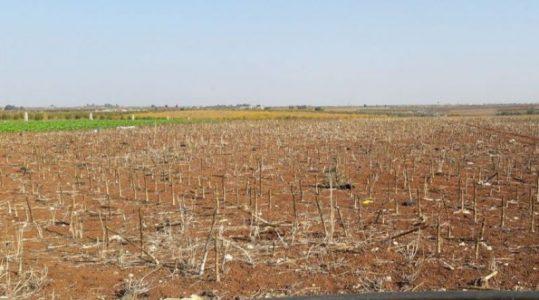
Mines are the lethal legacy that ISIS left in Syria’s Daraa governorate
Following the Syrian regime and the factions’, which reconciled with it, control over the Yarmouk Basin last August, the mines planted by the “Islamic State” in the Basin area, western rural Daraa, became a nightmare haunting the civilians intending to return to their lands and houses.
Similar to the former areas that the “Islamic State” existed, containing the dangers posed by the mines became a burden to the concerned civil organizations and foundations, for putting an end to the increasing number of mines’ victims is never an easy task, because the missing awareness campaigns have inflated the danger, threatening children on particular, which resulted in many registered explosions, ending with the death and injury of dozens of them.
The war remnants, mines and vacuum bombs, in the city of Daraa caused the death of several civilians last October.
The “Daraa Martyrs Documentation Office” has documents the death of seven people, including three children.
The Office, concerned with the documentation of casualties in Daraa, pointed out to the death of a woman and her child on October 14, in addition to the injury of another child in an explosion of a vacuum bomb and a land mine at the city of Jasim and the town of Tasil.
Another child and a person were killed in the city of Da’el and the town of al-Shajarah in a mine explosion, a leftover of the battles, in the same period, in addition to the explosion of a mine in the town of Eastern Ghariyah, eastern rural Daraa, which led to the death of a child and the injury of other four people.
The mines’ risk was not limited to human casualties as it developed to pose economic threats, promising a crisis in the foreseen future. The mines have forced the farm owners, at areas located at the confrontation lines, to forsake their lands fearing the mine “traps,” buried in their lands, turning them into rubble.
Abu Khalid from the town of Saham, northern rural Daraa, who refused to reveal his full name for security reasons, told Enab Baladi that, “I own a 20 dunum grape farm and a 25 dunum pomegranate farm. To the day, I could not cultivate them, fearing mines.”
“My major loss resulted from the drought of the grape harvest for three years, due to which the plants stunted are no more useful as a fruitful crop,” he added.
“The trees in my farm are all destroyed, but still none of the tractor owners dares to plough my land fearing that mines might exists there,” another farmer, from the town of Hayet, who also refused to reveal his name for security reasons, told Enab Baladi.
The risk violated the borders of the Yarmouk Basin, as it also covered the areas witnessing confrontations between the “Free Army” and the Assad’s forces, the latest effects of which was the explosion of an agricultural vehicle between the city of Da’el and the town of Ataman, northern rural Daraa, which killed two people from Da’el after they entered their lands on board of the vehicle early in November.
The young man Abdu Rahim al-Hariri, from the city of al-Harak, eastern rural Daraa, also died affected by his wound after the explosion of a land mine on November 27.
In addition to this, there are various cases of injuries which ended with amputation and deformities, but there are no official statistics about the whole number of these cases.
Source: Enabbaladi





